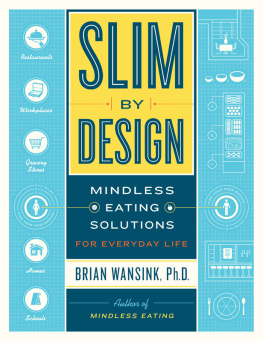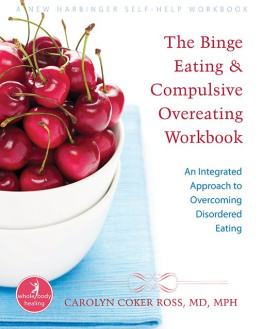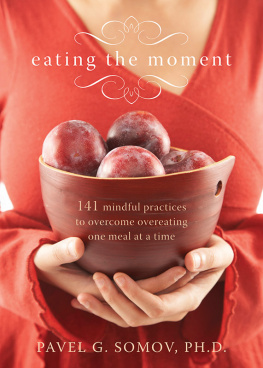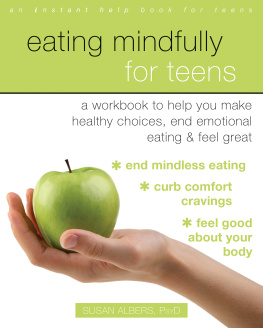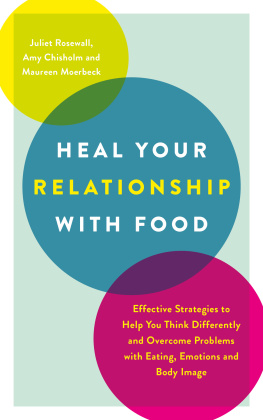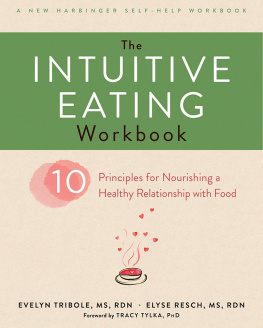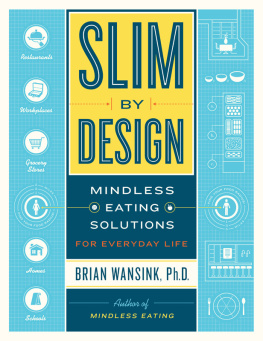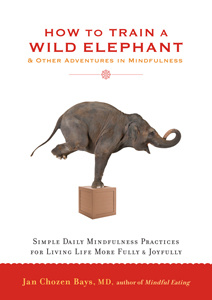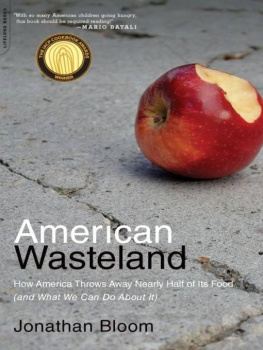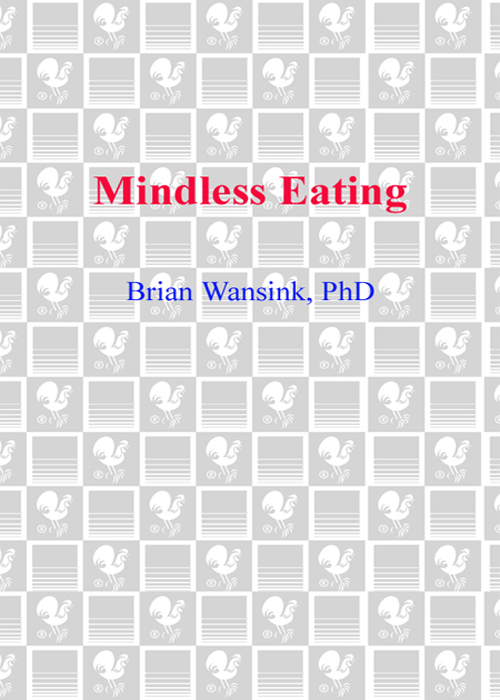
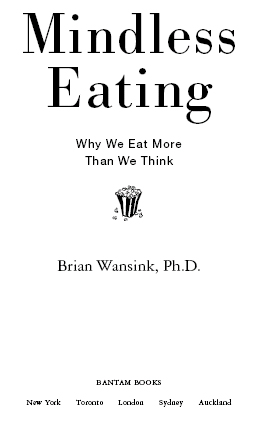
Contents

To my tireless past, current, and future
co-authors, colleagues, and students,
and to the patient academic journal editors
and insightful reviewers
who make our work better.
Introduction:
The Science of Snacking
E VERYONE EVERY SINGLE ONE of useats how much we eat largely because of whats around us. We overeat not because of hunger but because of family and friends, packages and plates, names and numbers, labels and lights, colors and candles, shapes and smells, distractions and distances, cupboards and containers. This list is almost as endless as its invisible.
Invisible?
Most of us are blissfully unaware of what influences how much we eat. This book focuses on dozens of studies involving thousands of people, wholike most of usbelieve that how much they eat is mainly determined by how hungry they are, how much they like the food, and what mood theyre in. We all think were too smart to be tricked by packages, lighting, or plates. We might acknowledge that others could be tricked, but not us. That is what makes mindless eating so dangerous. We are almost never aware that it is happening to us.
My labs research has shown that the average person makes well over 200 decisions about food every day.1 Breakfast or no breakfast? Pop-Tart or bagel? Part of it or all of it? Kitchen or car? Every time we pass a candy dish or open up our desk and see a piece of gum or a PowerBar from 1997 we make a food decision. Yet out of these 200-plus food decisions, most we cannot really explain.
But what if we could? If we knew why we ate the way we do, we could eat a little less, eat a little healthier, and enjoy it a lot more. This is why when it comes to what we eat, lots of people are interested. Getting people to eat healthy foods in the right amounts is of interest to dietitians, calorie counters, and physicians, but also to brand managers, parents, and even governments. Its also of interest to the U.S. Army, Better Homes and Gardens, and whoevers making your dinner tonight.
Since founding the Food and Brand Lab in 1997, I have designed and conducted over 250 studies, written over 100 academic articles, and made over 200 research presentations to governments and governors, to top universities and companies, to culinary institutes and research institutes, and I have presented my research results on every continent but Antarctica. Many of the studies in this book have been reported on the front pages of the Wall Street Journal and in the New York Times and USA Today. They have also been reported in the National Enquirer, Annals of Improbable Research, and Uncle Johns Bathroom Reader. Theyve been featured multiple times on 20/20, the BBC, and other network TV shows, and theyve been bantered about by Rush Limbaugh and berated by Dr. Laura.
Im on a mindless-eating mission. Still, Im never sure what to say when someone asks how I first became interested in food, psychology, and marketing. I usually say, I really liked Vance Packards 1957 book, The Hidden Persuaders, because he tried to show how advertising unconsciously influences us. I think this also happens when we eat, except the hidden persuaders are the way we set up our tables, our kitchens, and our routines.
While thats true, its not the whole truth.
MY BOYHOOD SUMMERS WERE spent with my brother and cousins on my uncle and aunts 138-acre farm near Correctionville, Iowa. The highlight of the end of every summer was the day Aunt Grace and Uncle Lester took us to town to see a movie, followed by a stop at a place I remember as the Dairy Freeze.
But in 1968, grain prices were low. When I innocently asked Uncle Lester why we werent seeing a movie that year, he summarized the state of agricultural economics in seven words, We would if people ate more corn. To an 8-year-old, this pretty much translated into If I ever hope to see a movie again, Id better think of a way to get people to eat more vegetables.
Fast-forward to 1984.
With a newly minted masters degree in communication research, I was working on a consulting project for Better Homes and Gardens (BH&G). One day, the director of editorial research, the late Ray Deaton, showed me four different BH&G cover ideas for an issue that was being published in 10 months. All four had the same cover photo and looked identical when I first saw them from four feet away. When I moved closer, I discovered the only thing that differed: the six cover blurbs, or teaser phrases, on the left side of the cover. Ray asked me to predict which cover would sell the most copies and why. I pointed to one and said, I think this one will do best because it uses shorter, little phrases. Without blinking, he said, Your intuition just cost us over a million dollars in newsstand sales. He went on to explain that every month BH&G took the best ideas for cover stories, developed four or more sample covers with a different mix of blurbs, and then asked over a thousand nonsubscribers which version they would be most likely to buy off the newsstand. With a circulation base of over 7.2 million readers, they did not use hunches and intuition. They did research so they could predict which magazine a blond, 37-year-old Wisconsin mother of two would pick up, flip through, and buy when standing in the checkout line at Safeway.
I was stunned. I was also hooked. Maybe I could learn to predict what foods people would eateven if they themselves could not.
Within six months I had applied to a Ph.D. program in Consumer Behavior at Stanford, telling them that I wanted to do research on how to get people to eat more vegetables. Six eye-opening years later, I was a marketing professor at the Tuck School of Business at Dartmouth College, with a fuzzy dream of starting a food psychology lab.
A LAB MAY CONJURE up images of test tubes, bubbling beakers, arcing electricity, and researchers with Einstein hair. Sometimes this is close to the truth, even in food research. Consider the physics of French fries. The Argonne National Laboratory helped McDonalds discover how to speed up the time it took to cook French fries. A team headed by physicist Tuncer Kuzay put sensors inside frozen French fries to best determine how to deal with the steam that was created by melting ice crystals. They then designed special frying baskets that cut 30 to 40 seconds off the frying time for each batch.2
In contrast, food psychology labs typically study human behavior, and these labs look like mock living rooms, kitchens, or restaurants. Some might be rigged with one-way mirrors, camouflaged cameras, and tables that have hidden scales under the plates. Others might include a row of cramped three-feet-wide tasting booths where people can taste-test different foods without being distracted. Still others might have small soundproof rooms for in-depth interviews or larger rooms where groups are brought in to answer psychological surveys related to food.
There are dozens of psychology labs that study food either part-time or full-time. They can be found at great universities in the United States, Britain, Canada, the Netherlands, France, Germany, Finland, and elsewhere. They can be found in the U.S. Army. Some of the more secretive ones can even be found in food companies.
Each of these labs uses different methods to study how we eat. But what all the noncommercial labs have in common is that they aim at publishing their findings in the best academic journals they can. Journals like the
Next page

